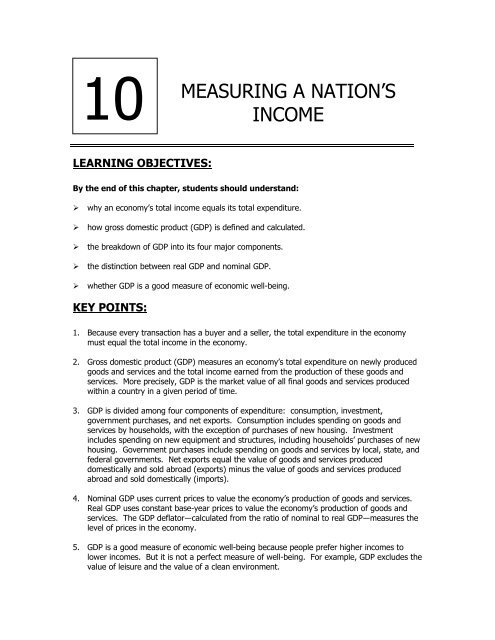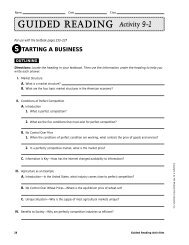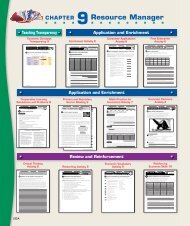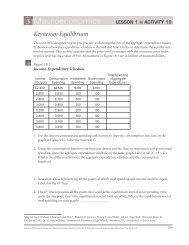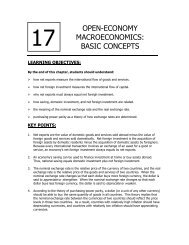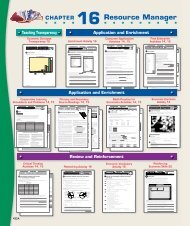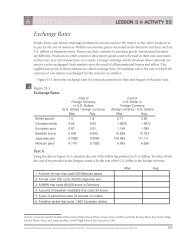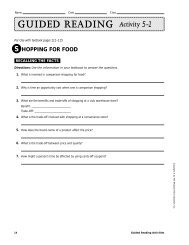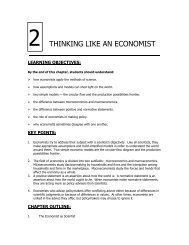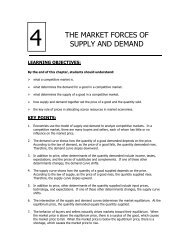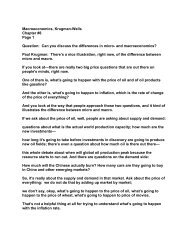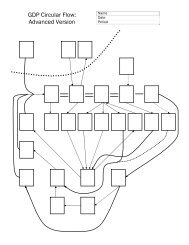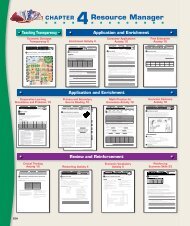Mr. Rasco's Chapter Notes - Rasco.name
Mr. Rasco's Chapter Notes - Rasco.name
Mr. Rasco's Chapter Notes - Rasco.name
You also want an ePaper? Increase the reach of your titles
YUMPU automatically turns print PDFs into web optimized ePapers that Google loves.
10MEASURING A NATION’SINCOMELEARNING OBJECTIVES:By the end of this chapter, students should understand:‣ why an economy’s total income equals its total expenditure.‣ how gross domestic product (GDP) is defined and calculated.‣ the breakdown of GDP into its four major components.‣ the distinction between real GDP and nominal GDP.‣ whether GDP is a good measure of economic well-being.KEY POINTS:1. Because every transaction has a buyer and a seller, the total expenditure in the economymust equal the total income in the economy.2. Gross domestic product (GDP) measures an economy’s total expenditure on newly producedgoods and services and the total income earned from the production of these goods andservices. More precisely, GDP is the market value of all final goods and services producedwithin a country in a given period of time.3. GDP is divided among four components of expenditure: consumption, investment,government purchases, and net exports. Consumption includes spending on goods andservices by households, with the exception of purchases of new housing. Investmentincludes spending on new equipment and structures, including households’ purchases of newhousing. Government purchases include spending on goods and services by local, state, andfederal governments. Net exports equal the value of goods and services produceddomestically and sold abroad (exports) minus the value of goods and services producedabroad and sold domestically (imports).4. Nominal GDP uses current prices to value the economy’s production of goods and services.Real GDP uses constant base-year prices to value the economy’s production of goods andservices. The GDP deflator―calculated from the ratio of nominal to real GDP―measures thelevel of prices in the economy.5. GDP is a good measure of economic well-being because people prefer higher incomes tolower incomes. But it is not a perfect measure of well-being. For example, GDP excludes thevalue of leisure and the value of a clean environment.
RevenueGoods & ServicesSoldFIRMSMARKETS FOR GOODS& SERVICES♦♦Firms sellHouseholds buySpendingGoods & ServicesBoughtHOUSEHOLDS♦♦Produce and sellgoods and servicesHire and use factorsof production♦♦Buy and consumegoods and servicesOwn and sell factorsof productionInputs forProductionMARKETS FOR FACTORSOF PRODUCTION♦♦Households sellFirms buyLand, Labor &CapitalWages, Rent & ProfitIncomeIII.The Measurement of Gross Domestic ProductA. Definition of Gross Domestic Product (GDP): the market value of all finalgoods and services produced within a country in a given period of time.B. “GDP is the Market Value...”1. To add together different items, market values are used.2. Market values are calculated by using market prices.C. “...of All...”1. GDP includes all items produced and sold legally in the economy.2. The value of housing services is somewhat difficult to measure.a. If housing is rented, the value of the rent is used to measure thevalue of the housing services.b. For housing that is owned (or mortgaged), the governmentestimates the rental value and uses this figure to value thehousing services.3. GDP does not include illegal goods or services or items that are not soldin markets.a. When you hire someone to mow your lawn, that production isincluded in GDP.
D. “...Final...”b. If you mow your own lawn, that production is not included inGDP.1. Intermediate goods are not included in GDP.2. The value of intermediate goods is already included as part of the valueof the final good.3. Goods that are placed into inventory are considered to be “final” andincluded in GDP as a firm’s inventory investment.a. Goods that are sold out of inventory are counted as a decreasein inventory investment.b. The goal is to count the production when the good is finished,which is not necessarily the same time that the product is sold.E. “...Goods and Services...”1. GDP includes both tangible goods and intangible services.F. “...Produced...”1. As mentioned above, current production is counted.2. Used goods sold do not count as part of GDP.G. “...Within a Country...”1. GDP measures the production that takes place within the geographicalboundaries of a particular country.2. If a Canadian citizen works temporarily in the United States, the value ofhis output is included in GDP for the United States. If an American ownsa firm in Haiti, the value of the production of that firm is not included inU.S. GDP.H. “...in a Given Period of Time.”1. The usual interval of time used to measure GDP is a quarter (threemonths).2. When the government reports GDP, the data is generally reported on anannual basis.3. In addition, data are generally adjusted for regular seasonal changes(such as Christmas).IV.FYI: Other Measures of Income
A. Gross National Product (GNP) is the total income earned by a nation’s permanentresidents.B. Net National Product (NNP) is total income of a nation’s residents minus lossesfrom depreciation (wear and tear on an economy’s stock of equipment andstructures).C. National income is the total income earned by a nation’s residents in theproduction of goods and services. It is equal to net national income minusindirect business taxes.D. Personal income is the income that households and noncorporate businessesreceive.E. Disposable personal income is the income that households and noncorporatebusinesses have left after taxes and other obligations to the government.V. The Components of GDPA. GDP (Y) can be divided into four components: consumption (C), investment (I),government purchases (G), and net exports (NX).Y = C + I + G + NXB. Definition of Consumption: spending by households on goods andservices, with the exception of purchases of new housing.C. Definition of Investment: spending on capital equipment, inventories,and structures, including household purchases of new housing.D. Definition of Government Purchases: spending on goods and services bylocal, state, and federal governments.1. Salaries of government workers are counted as part of the governmentpurchases component of GDP.2. Transfer payments are not included as part of the government purchasescomponent of GDP.E. Definition of Net Exports: spending on domestically produced goods byforeigners (exports) minus spending on foreign goods by domesticresidents (imports).F. Table 22-1 shows these four components of GDP for 1998.VI.Real Versus Nominal GDPA. There are two possible reasons for total spending to rise from one year to thenext.1. The economy may be producing a larger output of goods and services.2. Goods and services could be selling at higher prices.
B. When studying GDP over time, economists would like to know if output haschanged (not prices).C. Thus, economists measure real GDP by valuing output using a fixed set of prices.D. A Numerical Example1. Two goods are being produced: hot dogs and hamburgers.YearPrice ofHot DogsQuantity ofHot DogsPrice ofHamburgersQuantity ofHamburgers2001 $1 100 $2 502002 $2 150 $3 1002003 $3 200 $4 1502. Definition of Nominal GDP: the production of goods and servicesvalued at current prices.Nominal GDP for 2001 = ($1 × 100) + ($2 × 50) = $200.Nominal GDP for 2002 = ($2 × 150) + ($3 × 100) = $600.Nominal GDP for 2003 = ($3 × 200) + ($4 × 150) = $1,200.3. Definition of Real GDP: the production of goods and servicesvalued at constant prices.Let’s assume that the base year is 2001.Real GDP for 2001 = ($1 × 100) + ($2 × 50) = $200.Real GDP for 2002 = ($1 × 150) + ($2 × 100) = $350.Real GDP for 2003 = ($1 × 200) + ($2 × 150) = $500.E. Because real GDP is unaffected by changes in prices over time, changes in realGDP reflect changes in the amount of goods and services produced.F. The GDP Deflator1. Definition of GDP Deflator: a measure of the price level calculatedas the ratio of nominal GDP to real GDP times 100.GDP deflator =Nominal GDPReal GDP×1002. Example CalculationsGDP Deflator for 2001 = ($200 / $200) × 100 = 100.GDP Deflator for 2002 = ($600 / $350) × 100 = 171.GDP Deflator for 2003 = ($1200 / $500) × 100 = 240.G. Case Study: Real GDP Over Recent History
1. Figure 22-2 shows quarterly data on real GDP for the United States since1970.2. We can see that real GDP has increased over time.3. We can also see that there are times when real GDP declines. Theseperiods are called recessions.H. In the News: GDP Lightens Up1. Over the years, products produced in the U.S. have become lighter inweight due to changes in the types of products produced and theresources used.2. This is a Wall Street Journal article discussing comments made byFederal Reserve Chairman Alan Greenspan concerning this change.VII.GDP and Economic Well-BeingA. GDP measures both an economy’s total income and its total expenditure.B. GDP per person can tell us the income and expenditure level of the averageperson in the economy.C. GDP, however, may not be a very good measure of the economic well-being ofan individual.1. GDP omits important factors in the quality of life including leisure, thequality of the environment, and the value of goods produced but notsold in formal markets.2. GDP also says nothing about the distribution of income.3. However, GDP does help us achieve a good life. Nations with larger GDPgenerally have better education and better health care.D. Case Study: International Differences in GDP and the Quality of Life1. Table 22-3 shows real GDP per person, life expectancy, and adult literacyrates for 12 countries.2. In rich countries, life expectancy is higher and adult literacy rates arealso high.3. In poor countries, people typically live only into their fifties and onlyabout half of the adult population is literate.E. In the News: Hidden GDP1. Much of the economic activity in Russia now occurs in the undergroundeconomy.2. Many firms understate their levels of production to avoid paying hightaxes.
3. This is an article from The New York Times detailing this situation.


